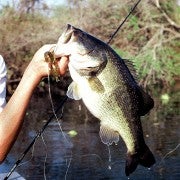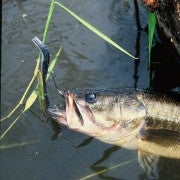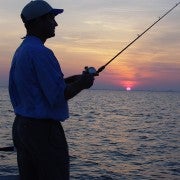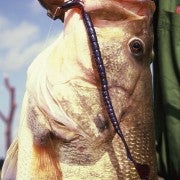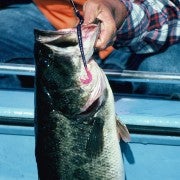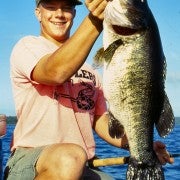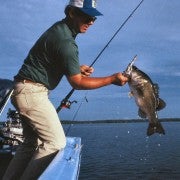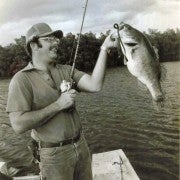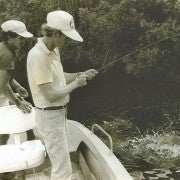Cuban chaos
Bob McNally 08.26.13

Jimmy Carter was in the White House. The Mariel boat lift was winding down. And nearly two dozen Americans were fishing from boats with Russian-made “Mockba” outboard motors in a virgin lake near the city of Moron, smack in the middle of Cuba.
It was the early 1980s, and while 125,000 Cubans seeking American freedom were pouring into South Florida (courtesy of Castro and Carter), American fishermen were quick to leap to the island nation in hopes of catching the next world record bass.
A number of Cuban bass lakes had been tested by U.S. anglers at that time, and reports of near-record largemouths were substantial from highly-touted Cuban waters like Treasure Lake and Lake Zaza.
That’s when I received a phone call from Dan Snow, a Houston entrepreneur who was setting up packaged fishing tours for American anglers to the island of Cuba. Snow wanted publicity, and said he was opening a new Cuban lake to anglers and wanted me to go.
Lake Redonda (“round” in Spanish) it was called, and it was infested with huge and gullible bass.
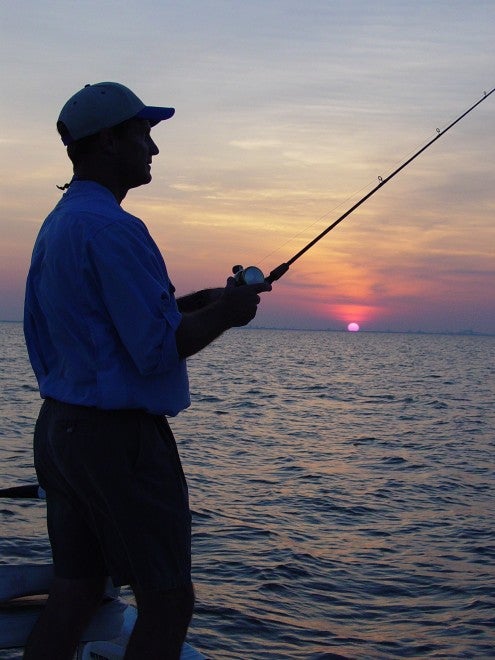
I was young and adventurous, and jumped at the chance to visit Cuba, though my wife and family were a little dubious. Inside I was, too, but you only live life once, and the fishing, photos and stories seemed incredible.
So a few weeks later 20 other fishermen and I left Fort Lauderdale in an old but reliable DC3 and flew two hours to the central Cuban city of Camaguay. From there we were met by an in-country tour guide named Jose, and drove three hours to the town of Moron. We were housed in a multi-story new hotel with clean sheets, hot water, a pool and television. Great modern conveniences, but in the shadows lurked the omnipresence of Fidel’s oppression and communism.
One night following a day of fishing, for example, all the anglers were being entertained in the hotel lobby for a cocktail party as we met local town dignitaries. We’d been there a couple days, and were more comfortable with our hosts and environment. In the middle of the cocktail party Jose (who spoke flawless English) explained to me and a few others that he had been in the Cuban army, and during his tour duty in Angola, Africa, had been wounded in combat.
I was speechless, not knowing how to respond. That’s when I noticed that over Jose’s shoulder was a large television set in a corner of the lobby, and Castro was giving one of his endless speeches.
Reality TV, Cuban style.
Hauling in the bass
Fishing may have been the centerpiece for dialogue and mutual respect between Americans and Cubans. But the oppression of Castro and communism seeped through the cracks as Jose talked of Angola, and Fidel rambled on about the proletariat.
Before it was over, the Cuban trip got even more bizarre, like something out of a surreal dream for an American like me who grew up in the era of Vietnam.
Yet the bass fishing on Lake Redonda was the star, and to this day is the best largemouth angling I’ve experienced anywhere at any time. And having lived in Florida for over 30 years, I’ve had some memorable days in many places, including California and Texas, Mexico and Honduras.
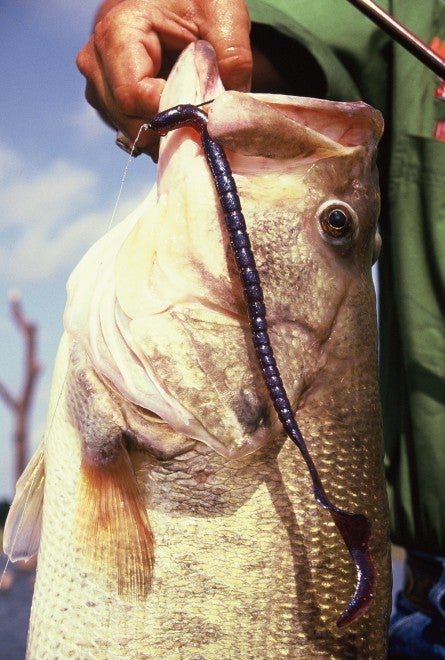
We fished Redonda three days, as the first modern Americans to tap the lake. And the bass acted like it. We’d fish from daybreak to mid-day, take a siesta and lunch in a lake-side cabana. Then fish from early afternoon until dark. Two men and a Cuban guide fished per boat, and I’d guess we caught 75 to 150 bass per day. They’d range all sizes, but there were staggering numbers of 4 to 8 pounders. Some touched 10 pounds, and the biggest I saw might have made 11 pounds.
But oh, how good the fishing was.
Redonda is clear, big and round, near the coast, and surrounded with a maze of tangle-root mangroves. It looks like South Florida snook country, though we never saw or heard of snook there. The lake held 50-pound class tarpon, however, and while we chased schools of them and cast to plenty, none were hooked.
Why chase tarpon when the bass action was among the best in the world?
One incident shows how phenomenal the fishing was. My boat partner and I were casting to a mangrove shore getting nice bass regularly, often seeing schools of 4 to 6 pounders swimming along. I spotted a solo 6-pounder in 4-feet of clear water holding just outside mangrove roots. I cast a 12-inch plastic worm to the fish, opting for big lures to thwart the constant strikes of small bass under 3-pounds. We watched the bass immediately come to my lure, suck it in, and I set the hook.
It fought great, cutting back left and right, but after a couple minutes I got control of the fish, only to have it leap high and throw my lure. I watched it plop down in Redonda’s clear water, then turn toward the mangroves and safety. I alerted my pal to the fish, and he immediately dropped a second plastic worm on it.
The 6-pounder hit his lure, slugged a bit, and then that second hook pulled free.
I was ready, spotted the mostly-whipped bass settle, and cast my plastic worm to it. It hit – for a third time – and I pulled in a beaten and incredibly unsophisticated bass. It surely was a fish that had never seen a lure, heard a motor, nor knew anglers were out-and-about.
Dated gear and common ground
There were no boat depth finders, and only weak electric motors, but the guides were skilled and enthusiastic. I remember the fiberglass boats were serviceable, but pretty rough. The outboards were Russian-made Mockbas, and they were a disaster. None had cowlings because they were worked on so frequently by guides and mechanics. To turn off a motor, a guide placed his hand over the exposed carburetor to choke off the engine.
In each boat there was a small flat pole onto which a large white pennant could be raised. The guide raised the flag when the motor died and couldn’t be restarted. That signaled a “rescue boat” that would travel around the lake looking for broken down boats, and would then swap out one Mockba for another.
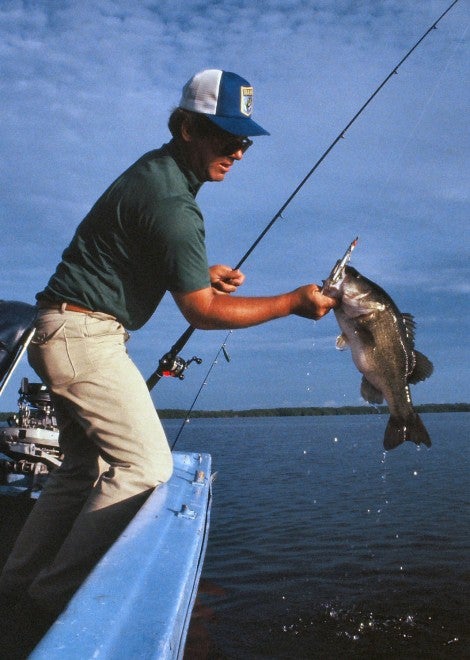
This was during the height of the Cold War, and the Russians were not our pals. So the joke of the Redonda trip was that “if Russians make ICBMs like they make Mockba outboard motors, the U.S. has nothing to worry about.”
Many of the guides wore tee-shirts with bright-color butterflies on them. I learned that “butterfly” is what Cubans called the lucky island inhabitants who “flew” from the island to the U.S. during Mariel, and the wearers of those tee-shirts envied those who made the American journey.
As happens with most anglers and guides, light chit-chat on a variety of subjects is common. While there was a bit of a language barrier between my Spanish-only speaking Cuban guide and me, we had common ground as boxing fans. He was a great admirer of boxing champ Roberto Duran. So was I, plus Wilfred Benitez, Carlos Palomino, Sugar Ray Leonard and Tommy Hearns. We got along fine while fishing.
After three days our hands were so worn raw from holding and releasing big Rodonda bass with sandpaper-like lips, that we had to tape our thumbs and fingers to prevent bleeding. I never experienced that before or since anywhere in bass country.
One afternoon our guides asked if anyone wanted to shoot a few pigeons and doves. I jumped at the opportunity, because the incongruity of armed Americans wandering around the Cuban communist countryside was just too good not to experience. I was loaned a side-by-side shotgun that looked old enough to have been used by the Conquestadors, with double triggers, and chokes as tight as a 30.06. I didn’t hit much with it, but the birds were there, and the guides wanted every one to eat at home.
Memories of that Cuban fishing trip are still vivid. I recall that residents said the lake and surrounding area had been owned at one time by the famed folks of the King Ranch in Texas. They stocked Redonda with bass back in the 1920s, and enjoyed fishing it until Fidel “nationalized” it following the “revolution.”
Though we were many miles from cities and large towns, when driving to and from the lake for fishing we passed numerous small shacks, where light filtering through exterior walls and windows showed every home had a television. Often the TVs were tuned to a Fidel speech, in a tiny house that likely didn’t have indoor plumbing – though every one had a communist-financed TV.
Mind control maybe?
A missed opportunity
Unquestionably the biggest disappointment of the Cuban trip was not making the greatest photograph of my life.
As we were driving back to the Camaguay airport, Jose told our busload of fishermen that there were military aircraft on the runway. Taking photos at the airport would be a security threat, and any cameras seen would be confiscated and not returned.
We arrived and there were six Russian-made MiG jet fighters parked in a row near the small airport terminal. As I walked around a circular driveway in front of the terminal, I noticed a park bench with a Cuban man sitting on it. I walked over, glanced up at the MiGs, and in that singular frame of sight I could see: the jets in the background; a large bronze bust of Jose Marti (the 1880s “Apostle of Cuban Independence”) behind the park bench; the old brown-and-leathery face Cuban man puffing a huge Cuban cigar; and atop his head was a New York Yankees baseball cap.
Incongruity personified, and I couldn’t shoot the picture. But I was tempted, oh how I was tempted.
